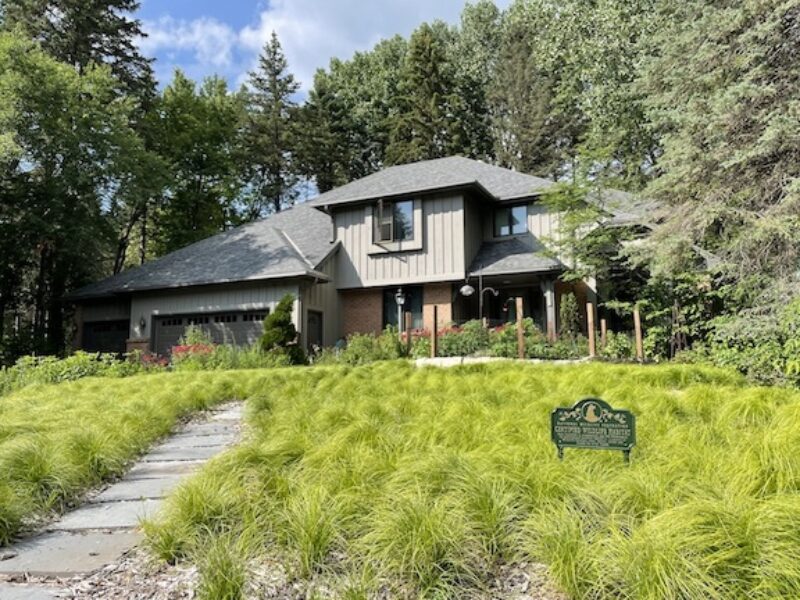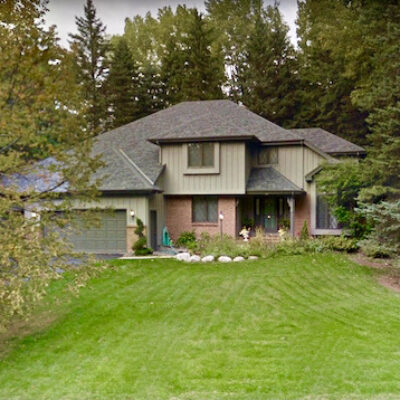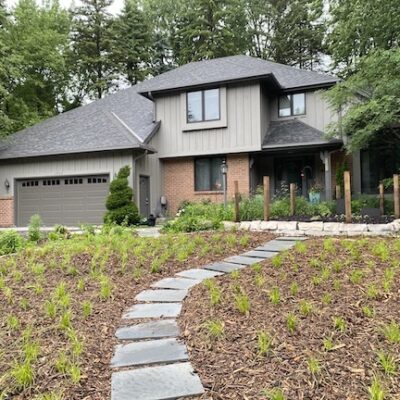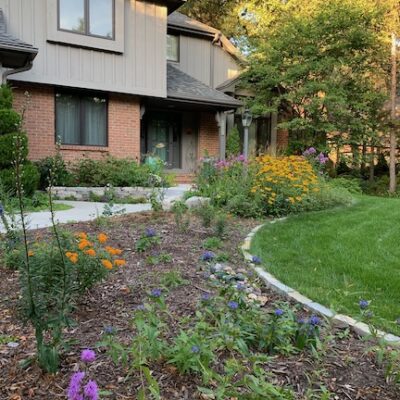
For Dana Boyle, a Twin Cities metro resident, a Lawns to Legumes grant was part of a yard transformation which had been percolating over several years, and which she writes about below. We visited Dana and asked her some questions about her project. In the following video links, she talks about how she converted her lawn to Pennsylvania sedge and some of the ideas used in the design of her pollinator gardens. Her yard attracts hummingbirds, butterflies and bees — including, this year, the endangered rusty patched bumble bee. Photos courtesy of Dana Boyle.
Video Links
The Lawns to Legumes program provides cost-share grants to Minnesota residents to create pollinator habitat in their yards. It comes through the Minnesota Board of Water and Soil Resources.
A Yard Evolves
by Dana Boyle
 Volunteering as a Minnesota Master Naturalist in the Blue Thumb booth at the MN State Fair several years ago planted the seed for this project. Then I read Douglas Tallamy’s book, Bringing Nature Home, which I learned about at a Wild Ones conference. It also helped to see a neighbor’s pollinator garden to know that shifting to pollinator plants was doable. Once the idea marinated, I became committed to change and moved from a turf yard to a native one.
Volunteering as a Minnesota Master Naturalist in the Blue Thumb booth at the MN State Fair several years ago planted the seed for this project. Then I read Douglas Tallamy’s book, Bringing Nature Home, which I learned about at a Wild Ones conference. It also helped to see a neighbor’s pollinator garden to know that shifting to pollinator plants was doable. Once the idea marinated, I became committed to change and moved from a turf yard to a native one.

The first year, I focused on the “margins” of my front yard. With the design help of my friend (and landscape architect) Diane Hilscher, I carved out turf and replaced it with flowering native plants and grasses. I made sure to edge that section in stone to show that it was intentional. The next year, I hired Douglas Owens-Pike to come up with a design that would allow us to rip out the remaining turf and replace it with native Pennsylvania sedge plugs. To enhance the look, he designed stone pathways and installed a front-yard vegetable garden. As an added benefit, I was given a Lawns to Legumes grant.
The whole project was unorthodox for my neighborhood, which has a homeowners association with stringent covenants. This required a thoughtful approach, on my end, to gain the approval of our association board. They had questions and concerns but ultimately gave conditional approval to move forward.
 The main front yard work was done last summer and, already, the yard looks lush and healthy — despite the intensely hot and dry summer. I know that some people in the neighborhood were initially thrown by the difference of my yard, but it seems from comments this year that they’re okay with it, now that the sedges have grown together to create a more uniform look. Others — especially younger homeowners and those with kids — were enthusiastically supportive from the start. It’s ever clearer that this is about changing culture, and that takes time and a gentle but firm hand in leading that within a conventional context.
The main front yard work was done last summer and, already, the yard looks lush and healthy — despite the intensely hot and dry summer. I know that some people in the neighborhood were initially thrown by the difference of my yard, but it seems from comments this year that they’re okay with it, now that the sedges have grown together to create a more uniform look. Others — especially younger homeowners and those with kids — were enthusiastically supportive from the start. It’s ever clearer that this is about changing culture, and that takes time and a gentle but firm hand in leading that within a conventional context.
_____________________________
Additional Resources
- This project has been included in the Smithsonian’s Community of Gardens: “Walking the Talk in the Suburbs – A Midwest story of education, transformation, and inspiration”; Community of Gardens, https://communityofgardens.si.edu/items/show/12425
- To learn more about turf alternatives or planting for pollinators, consider a Blue Thumb workshop. We offer the following: Resilient Yards, Bee Lawns and Planting for Pollinators. Learn more here.
- Apply for a Lawns to Legumes cost-share grant to help you create pollinator habitat. Also, check the Board of Water and Soil Resources’s Lawns to Legumes page for resources on creating pollinator habitat.
